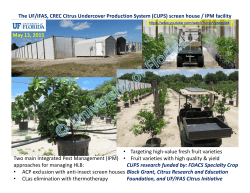
Control citrus HLB by blocking the functions of two critical effectors
C I T R U S A D VA N C E D T E C H N O L O G Y P R O G R A M QUARTERLY & FINAL REPORTS: Control of Citrus Greening, Canker & Emerging Diseases of Citrus SELECT PERIOD March Quarterly Report 2015 Final Proposal Title Control citrus HLB by blocking the functions of two critical effectors encoded by 'Candidatus Liberibacter asiaticus' Today’s Date 4/16/15 Sponsoring Organization (drop-down) Category (drop down) Citrus Research and Development Foundation Unclassified REPORT UPDATE (500 words-It is not necessary in this public report to disclose your institution's proprietary information or intellectual property.) The objectives of this project are to characterize the molecular interactions between the effectors and the host mitochondrial proteins; to screen for molecules that inhibit the effector functions; and to control HLB using the inhibitor(s) and/or other related molecules. Although we previously reported that LasAI and LasAII target host mitochondria, we had to co-inoculate the gene silencing suppressor P19 to have a detectable expression of LasAI and LasAII (PLoS ONE8:e68921, 2013). After optimization for a variety of parameters that are critical for efficient gene expression in plants, high expression level of LasAI/LasAII were detected without co-inoculation of P19. Transgenic Arabidopsis plants expressing lasAI or lasAII showed a different degree of impaired growth. In particular, the LasAI contains domains responsible for abnormal growth of the root and/or meristem. Trangenic citrus plants expressing Las AI also display growth retardation. Meanwhile, to further study the function of LasAI in citrus, transgenic citrus were generated to express LasAI, LasAI N-terminal, LasAI C-terminal, LasAI repeat region, LasAII and GFP control, respectively. We have obtained transgenic citrus plants transformed with different domains of LasAI, and they are under evaluation of transgene expression and the host response to the transgene. Transient expression of LasAI and three different LasAI domains, LasAI-N-terminal, LasAI-repeat, LasAI-C-terminal allowed us to visualize the sub-cellular localizations of different domains. Because of high level expression of these effector proteins, we developed a novel in vitro screening system that can evaluate small molecules against these Las effectors. The library consists of more than 30 million compounds obtained from the small molecule libraries of the TPIMS (Torrey Pines Institute for Molecular Studies). Interestingly, a few groups of compounds showed interference activity against the mitochondrial localization of LasAI. Meanwhile, to concert this screening, we developed another in vitro screening system in conjunction with the culture screening using Liberibacter cresence (Lcr). From these screening of 65 scaffold chemicals, we identified a number of chemical groups that disrupted the interaction between LasA1 and mitochondria and inhibit both Las and Lcr growth. We are narrowing down to individual compounds that inhibit the function of the Las AI effector or kill Las bacteria via other pathways. In addition, another hypothetical protein has been expressed in planta via transient and stable transformation, and founded to affect host resistance to a bacterial pathogen. The antibody against this protein was able to detect this antigen both in the transgenic plants and in the Las-infected plants. Meanwhile, the Western blot results revealed unique formation of this protein in E. coli and plants. Citrus plants with high level expression of this transgene displayed HLB-like symptoms, yellow shoot and impaired growth. Further characterization of this effector revealed its unique sub-cellular localizations. Understanding the molecular mechanism of how the effector induces HLB-like symptom is underway. We also analyzed the expression of LasA1 in Las-infected citrus plants. RT-PCR results indicate that LasA1 expression is correlated with severity of HLB symptoms. In particular, LasA1 was expressed more in the yellow leaves or the yellow spots than green spots of the symptomatic leaves with blotchy mottle. The interaction between LasA1 and the putative host receptor identified is characterized using the yeast two hybrid systems. PI First Name Yong-Ping Organization USDA-ARS-USHRL PI Last Name Duan Project Number Email Yongping.duan@ars.usda.gov Project Duration (years) 3 Phone 772-462-5840 Total Funds (current year) $135,002.00 Form PR-12 Quarterly Reports 717 Year of Project 2 SUBMIT REPORT
© Copyright 2025










